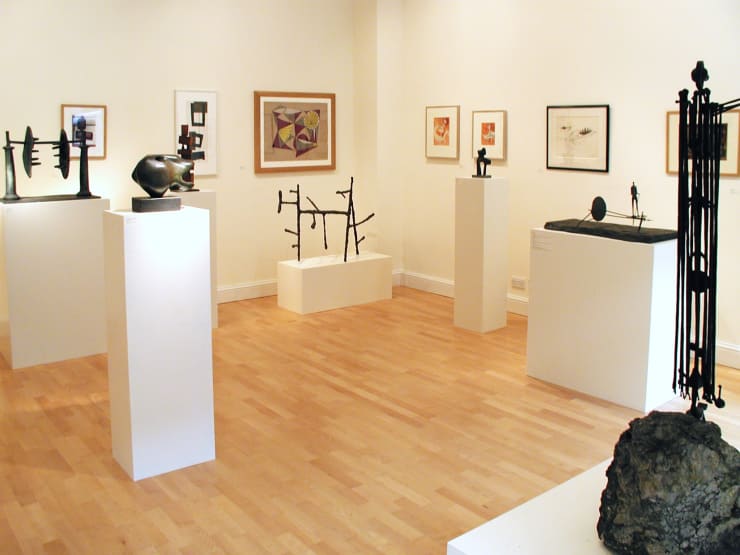Major exhibition of Important sculpture and works on paper by Robert Adams, Kenneth Armitage, Reg Butler, Lynn Chadwick, Geoffrey Clarke, Bernard Meadows, Henry Moore, Eduardo Paolozzi and William Turnbull.
Exactly fifty years ago this year the British Pavilion at the Venice Biennale presented a major exhibition entitled New Aspects of British Sculpture. Outside the pavilion the visitor was greeted with major works by Henry Moore and Reg Butler and inside there was a dramatic installation of the leading young British sculptors of the day, including Robert Adams, Kenneth Armitage, Lynn Chadwick, Geoffrey Clarke, Bernard Meadows, Eduardo Paolozzi and William Turnbull.
In the catalogue for this exhibition Herbert Read wrote of the anxiety he associated with the contemporary world and of the `iconography of despair' created by these artists. In a reference to the figuration of these sculptors and the preference of many of them for welded iron, Read described their figures as `iron waifs' whose forms represented a `geometry of fear'.
In celebration of this major event in the history of British sculpture, James Hyman Gallery is delighted to present an exhibition of work by these seminal artists.
At the heart of the show is one of the most important `geometry of fear' sculptures, Geoffrey Clarke's unique welded iron figure entitled Complexities of Man (1951), which was one of the major works at the Venice Biennale in 1952.
Henry Moore and the Geometry of Fear gives prominence to this art historically important moment, including works shown in Venice and related pieces from this period by these leading Modern british Artists. It presents major bronzes by Moore, Paolozzi's powerful Forms on a Rod (1948-49), sculptures in wood by Adams and characteristic early sculptures by Butler, Chadwick and Armitage.
The exhibition also includes a selection of major works on paper, including drawings, watercolours and collages.
The exhibition is accompanied by the first major book on the Geometry of Fear, with essays by Margaret Garlake and James Hyman.
SELECTED REVIEWS
"Meatier fare was provided by Henry Moore and the Geometry of Fear, mounted by James Hyman Gallery (closed 18th January), the impetus for which was the fiftieth anniversary of the exhibition New Aspects of British Sculpture at the 1952 Venice Biennale. This gave international exposure for the first time to a group of eight young British sculptors - Robert Adams, Kenneth Armitage, Reg Butler, Lynn Chadwick, Geoffrey Clarke, Bernard Meadows, Eduardo Paoand William Turnbull -- whom Herbert Read, in an influential catalogue text written at the height of the Korean War, credited with creating an evocative 'iconogof despair'. Their `iron waifs', whose spindly, etiolated forms were often anchored by contrastingly massive bases, implied to Read a `geometry of fear', forbiddingly expressed in Clarke's Complexities of man (Fig.51). (In Venice, the original roughly hewn boulder on which it stands, and with which it was here reunited, was substituted by a comparatively flimsy wooden pyramid, which greatly diminished its impact.) In this show, as in 1952 when his Double standing figure was placed outside the entrance to the British pavilion, Moore was represented by just one piece. His 1951 bronze Animal head, a figure that mutates between life and death, was, however, judiciously chosen to undermine the conventional positioning of this generation of sculptors in stark reaction to that of Moore. Although they eschewed carving in favour of welding and took their lead from France, from Giacometti, Picasso, Gonzalez and even, in the case of Clarke's Table-top still life, from Braque, there are suggestive parallels with Moore's disquieting allegories of the 1950s as well as with the contemporaneous edgy realism of Bacon and Sutherland. The layout of Hyman's exhibition deliberately mimicked that of the British pavilion, with sculptures supported on plinths of varying heights, pushed away from the walls, on which were hung related works on paper. Besides Clarke's masterpiece, it included two other pieces shown at Venice: Turnbull's wiry Horse and Adams's Divided pillar. This was an exemplary small show that would not have disgraced a public gallery, and was accompanied by a scholarly and handsome catalogue which very usefully includes close-up reproductions of those sculptures whose battered and beaten surfaces Read characterised as conveying a `patina of pathos', as well as photographs from multiple angles of pieces such as Moore's Animal head which need to be viewed in the round."
James Beechy, Burlington Magazine, February 2003
"The show is primarily about the sculpture of the period, along with the drawings these artists did in preparation for sculpture. The show is dominated by Geoffrey Clark's Complexities of Man (1951), a spindly iron construction anchored to a roughly hewn rock, very much in the manner of Reg Butler's winning (unexecuted) design for the Unknown Political Prisoner international competition. But many of the other works on show retain their ability to play on unnameable fears: witness Eduardo Paolozzi's Forms on a Rod (1949), which says nothing precise yet summons up visions of the utmost terror."
The Times, 27 November 2002
"'Henry Moore and the Geometry of Fear' is the intriguing second exhibition to be staged by James Hyman Gallery at their new gallery, 6 Mason's Yard, Duke Street, St James's. Running until 18 January, it comprises enigmatic and thought-provoking sculptures and works on paper by the likes of Henry Moore, Robert Adams, Bernard Meadows and Lynn Chadwick, all of whom present visual critiques of an embittered modem world."
Round The Galleries, APOLLO, January 2003
"It rocked poor old Antennae's cage more than somewhat (tempus fugit and all that) to realise that this famous phrase of Herbert Read's, marking a seminal moment in British modernism's acceptance into the European mainstream, was coined some 50 years ago! Used to describe the angst-ridden postwar sculpture of Paolozzi, Chadwick, Butler, Moore, Clarke, Turnbull et al shown at the XXVI Venice Biennale in 1952, the moment is enterprisingly relived in a show at James Hyman, with one of the major works in Venice, Geoffrey Clarke's Complexities of Man, the centrepiece."
Nicholas Usherwood, Antennae, GALLERIES, December 2002




